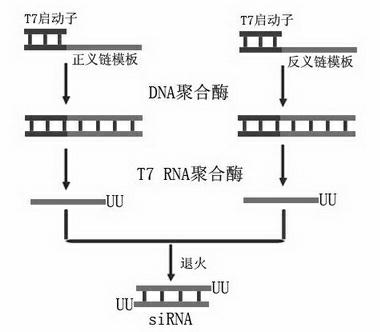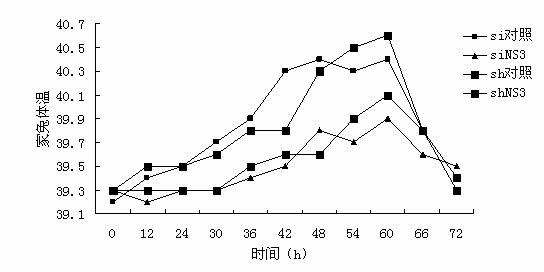Small-interfering RNA (siRNA) capable of inhibiting classical swine fever virus (CSFV) reproduction and infection as well as preparation method and application thereof
A swine fever virus, small interference technology, applied in DNA/RNA fragments, antiviral agents, recombinant DNA technology, etc., can solve the problem of not completely preventing and controlling swine fever epidemics
- Summary
- Abstract
- Description
- Claims
- Application Information
AI Technical Summary
Problems solved by technology
Method used
Image
Examples
Embodiment 1
[0101] The target sequence of embodiment 1 siRNA action:
[0102] 1. siRNA that can inhibit CSFV replication and infection
[0103] After using RNA interference technology to design and synthesize siRNA, these siRNA can specifically and efficiently inhibit the proliferation of CSFV and thus have a significant therapeutic effect on CSFV infection. The target sequence of siRNA action and its position in the CSFV genome are shown in Table 13:
[0104] targeting genes
[0105] *: Position relative to reference strain shimen, GenBank accession number: AF092448.
Embodiment 2
[0106] Example 2 Synthesis of siRNA in vitro:
[0107] According to the instructions of T7 RiboMAX Express RNAi System (Promega), design and synthesize the DNA sequence of the siRNA molecule and the T7 RNA polymerase binding sequence of the three fragments selected in Example 1, see the attached figure 1 ; respectively synthesize the template DNA for transcribing the sense strand and antisense strand of each siRNA molecule, the sequence is as follows:
[0108] T7 RNA polymerase binding sequence: 5'GGATCCTAATACGACTCACTATA 3'
[0109] NS3-1 sense strand template sequence:
[0110] 5'AATTGTATTCCACTCATAAGCTATAGTGAGTCGTATTAGGATCC 3'
[0111] NS3-1 antisense strand template sequence:
[0112] 5'AAGCTTATGAGTGGAATACAATATAGTGAGTCGTATTAGGATCC 3'
[0113] NS3-2 sense strand template sequence:
[0114] 5'AATAACTTAGGTTGTGGCATCTATAGTGAGTCGTATTAGGATCC 3'
[0115] NS3-2 antisense strand template sequence:
[0116] 5'AAGATGCCACAACCTAAGTTATATAGTGAGTCGTATTAGGATCC 3'
[0117] NS3-3 sense ...
Embodiment 3
[0130] Example 3 The design method of plasmid expression shRNA:
[0131] According to the design requirements of pSilencer3.1H1 Hygro (Ambion) shRNA vector, design the DNA sequence for expressing shRNA, and the restriction sites at both ends are Bam H I and Hind Ⅲ. The designed and synthesized primers are shown in Table 15.
[0132]
[0133] Specific steps are as follows:
[0134] Synthesize four plasmids producing shRNA molecules according to the following steps, dilute the synthesized single-stranded DNA to 100 μmol / L, and synthesize them into double-stranded DNA by PCR method: Take 25 μL of each diluted DNA and place in a PCR machine Denature at 95°C for 2 min, then at 56°C for 30 s. After the reaction, add 5.0 μL of 3 mol / L sodium acetate (pH 5.2), then add 2.5 times the volume of absolute ethanol, mix well, place at -20°C for 10 min, centrifuge at 12,000 r / min for 10 min, discard the upper For the supernatant, wash the precipitate with 1000 μL of 70% ethanol, disc...
PUM
 Login to View More
Login to View More Abstract
Description
Claims
Application Information
 Login to View More
Login to View More - R&D
- Intellectual Property
- Life Sciences
- Materials
- Tech Scout
- Unparalleled Data Quality
- Higher Quality Content
- 60% Fewer Hallucinations
Browse by: Latest US Patents, China's latest patents, Technical Efficacy Thesaurus, Application Domain, Technology Topic, Popular Technical Reports.
© 2025 PatSnap. All rights reserved.Legal|Privacy policy|Modern Slavery Act Transparency Statement|Sitemap|About US| Contact US: help@patsnap.com



